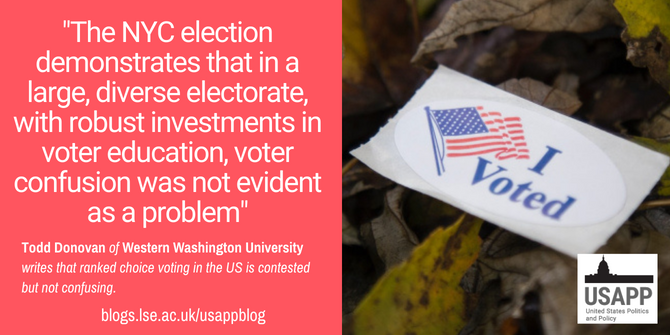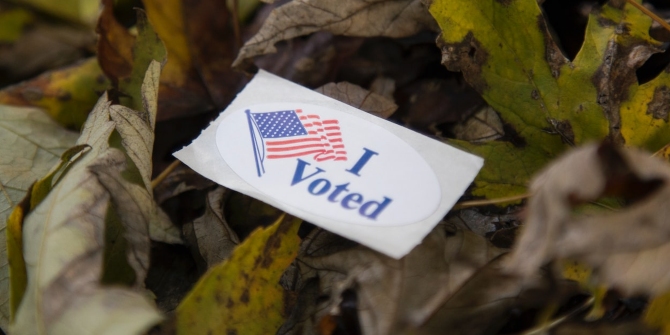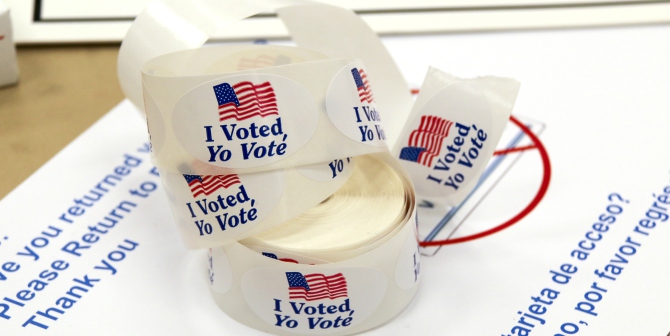 In addition to the candidates vying for re-election in November, ranked choice voting (RCV) referendums will also be on the ballot in many states, cities, and counties. Todd Donovan looks at the recent history of RCV in the US, and highlights that partisan divisions are not a consistent feature in support or opposition. While some opponents have argued that RCV is confusing, he writes that evidence from New York City’s 2021 mayoral primary election and other contests show that there is a high level of understanding among voters.
In addition to the candidates vying for re-election in November, ranked choice voting (RCV) referendums will also be on the ballot in many states, cities, and counties. Todd Donovan looks at the recent history of RCV in the US, and highlights that partisan divisions are not a consistent feature in support or opposition. While some opponents have argued that RCV is confusing, he writes that evidence from New York City’s 2021 mayoral primary election and other contests show that there is a high level of understanding among voters.
Ranked choice voting (RCV) has been back in the news in recent weeks, after the former Governor of Alaska, Republican Sarah Palin, lost a special election for Alaska’s at-large US House seat, which used the system, to Democrat, Mary Peltola. Peltola and Palin will face a rematch under the same system, along with two other candidates, on November 8th.
RCV is also on ballots across the US in November. RCV is preferential voting, where voters rank multiple candidates. Successive rounds of counts eliminate candidates until someone can hold a majority. Results from referendums on RCV, and elections held under RCV, may affect momentum behind this reform effort. One recurring critique of RCV is that it is confusing. Evidence from the largest RCV election held in the US suggests otherwise.
Ranked Choice Voting in the US
In November, Seattle and Portland, Oregon will have referendums on adopting RCV. Additional measures will appear on ballots in other cities and counties, and on the Nevada state ballot. Local and statewide contests will also be contested via RCV, including the two-year Alaska US House race featuring Sarah Palin.
Nevada’s ‘Top 5’ citizens’ RCV initiative is similar to Alaska’s ‘Top 4’ initiative that voters narrowly approved in 2020. It would replace partisan primaries for statewide, congressional, and state legislative offices with an open primary where the top 5 (regardless or party) advance, followed by a general election using RCV to pick a winner from those. Alaskans first made use of RCV in an August 16, 2022 special election for a short-term US House vacancy with Democrat Peltota at 40 percent in the round, followed by Trump-endorsed Palin at 31 percent, and Republican Nick Begich at 28 percent. Enough preference transfers from Begich gave the short-term seat to Peltota.

Photo by Josh Carter on Unsplash
If Nevadans eventually approve RCV, they will join Maine and Alaska in using RCV at the state level. Maine now uses RCV in state-wide primaries and all federal races, including the November 2020 presidential election. Massachusetts voters rejected an RCV initiative in 2020.
About 50 cities have also adopted RCV in the past decade or so. At the local level, proposals have been placed on ballots by city councils (as in Seattle) or referred to voters by charter review commissions (as in Portland). New York City’s Charter Review Committee referred RCV to the 2019 ballot, when 75 percent of voters approved it. As with rules changes such as legislative term limits and redistricting commission, state-level attempts at RCV have all been via direct democracy.
Partisan views
Prominent US cities adopting RCV have been left-leaning, and Republican governments in Florida and Tennessee recently banned local adoption of RCV. Republican Party organizations have also opposed RCV proposals. Nevertheless, partisan divisions are not a consistent feature in support or opposition for RCV. Alaska, and cities in Utah adopted it and six solidly red southern states use RCV for overseas and military voters. Some opposition may reflect incumbency. Earlier this year, a California Democrat introduced a bill to ban RCV, and majority legislative Democrats and their allies fund opposition to RCV in Nevada. New York’s Democratic mayor Eric Adams, and Republican Palin, have both opposed RCV .
RCV provides no clear electoral advantages to either major party. Winners overwhelmingly reflect first round leaders, like Peltola and Adams. Australia’s two major parties, Labor and Liberal/National, win nearly every seat in the Australian House under RCV along with a few independents. Polls do show a divide in the US, with Republicans having less favorable views than Democrats. Donald Trump called Alaska’s RCV “crap” because “you never know who won.”
The arguments: confusion
Proponents suggest ranked choice voting (RCV) could mitigate spoiler effects (where candidates with similar ideologies split the vote), produce majority winners, reduce negative campaigning, and diversify the candidate pool. Several incumbent Democrats, incumbent Republicans, officials from both major parties, and others agree with Palin, at least in their political arguments, that RCV is too complex and confusing . Research has addressed some of the proponent’s claims, but among incumbent politicians, the assumption of voter confusion finds bi-partisan support. Voter confusion is of concern because it could be particularly problematic if more prevalent among race / ethnic minorities, and thus somehow dilute the influence of minority voters.
Learning from Americas biggest RCV election
New York City conducted America’s largest RCV election for its June 22, 2021, mayoral primary, with nearly a million voters participating. The city allocated $15 million to voter education prior to the election, advertising via TV, print, radio, billboards, subway ads and digital media. Exit polls allow tests of how voters perceived their levels of understanding of RCV, and measure how many utilized multiple rankings.
Analyses of the NYC exit poll in my forthcoming paper found high levels of self-reported understanding of voting instructions, and of RCV, with no differences across race / ethnic groups. Ninety-three percent of New Yorkers found it was somewhat easy or very easy to understand voting instructions, with 70 percent saying instructions were very easy to understand. Seventy-eight said they understood RCV extremely well or very well, with just four percent saying “not well at all.” Eighty-seven percent ranked multiple mayoral candidates. Nearly 80 percent of voters wanted to keep using RCV in NYC. All this suggests the voter education campaign was a success.
Over 80 percent Black and Hispanic voters, respectively, ranked multiple candidates, but they were less likely to rank than whites. However, Adams had condemned appeals for second preferences as “suppression” of Black voters. Nearly half of his support came from Black voters, and one-fifth of his voters did not rank anyone else for mayor. Given that ninety-five percent of Adams’ voters said instructions were easy, this lower propensity to rank may reflect the candidate’s orientation toward RCV, not voter misunderstanding.
High levels of reported understanding and use of RCV are not unique to NYC. Exit polls from RCV contests in Utah and California cities also found high levels of reported understanding, with the latter study finding no race/ethnic differences. But the NYC election demonstrates that in a large, diverse electorate, with robust investments in voter education, voter confusion was not evident as a problem. Experimental evidence suggests experience with RCV elections may further increases understanding of RCV, and support for it.
Changes in electoral rules are often resisted by self-interested incumbents, and there are valid reasons beyond self-interest to challenge reforms such as RCV . For opponents of RCV, however, the voter confusion argument does not stand up to the evidence.
Please read our comments policy before commenting.
Note: This article gives the views of the author, and not the position of USAPP – American Politics and Policy, nor the London School of Economics.
Shortened URL for this post: https://bit.ly/3QtwxMd
About the author
 Todd Donovan – Western Washington University
Todd Donovan – Western Washington University
Todd Donovan is Professor of Political Science at Western Washington University, with previous visiting appointments and fellowships in Australia and New Zealand. He has been involved with public opinion surveys in the US, UK, and other countries. His research examines the intersection of political behavior, representation and electoral institutions, as well as public opinion, direct democracy, and elections.






